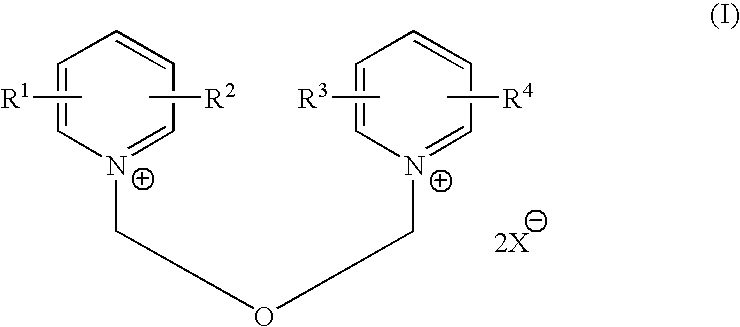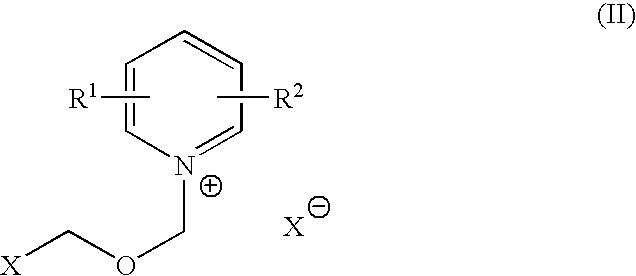Process for halomethyl ethers of hydroxyiminomethyl quaternary pyridinium salts
a technology of hydroxyiminomethyl quaternary pyridinium salt and process chemistry, which is applied in the direction of heterocyclic compound active ingredients, biocide, organic chemistry, etc., can solve the problems of high level of undesired co-products, low yield, and difficult manufacture of antidotes with asymmetrical structure, so as to improve product yield and product purity.
- Summary
- Abstract
- Description
- Claims
- Application Information
AI Technical Summary
Benefits of technology
Problems solved by technology
Method used
Image
Examples
example 1
Comparative Study: Preparation of 1-(2-Hydroxyiminomethyl-1-Pyridino)-3-(Chloromethyl)-2-Oxapropane, Chloride Salt, by Process of This Invention vs. Process of the Prior Art
[0031] This example compares the yield and purity of 1-(2-hydroxyiminomethyl-1-pyridino)-3-(chloromethyl)-2-oxapropane, chloride salt as obtained by the process of the present invention with the yield and purity as obtained by the reverse order of reactant addition as disclosed in Hagedorn, I., et al., U.S. Pat. No. 3,773,775, Example 10. The structure of 1-(2-hydroxyiminomethyl-1-pyridino)-3-(chloromethyl)-2-oxapropane, chloride salt is as follows:
[0032] For both procedures, bis-chloromethylether was prepared by first cooling a mixture of paraformaldehyde (21.1 g, 0.7 mole) and 37% hydrochloric acid (16.7 g ) to 10° C., then slowly adding chlorosulfonic acid (55.1 g, 0.6 mole) and stirring overnight. The phases were then separated to obtain bis-chloromethylether as the neat liquid. The procedure used for this...
example 2
Illustrating This Invention: Conversion of 1-(2-Hydroxyiminomethyl-1-Pyridino)-3-(Chloromethyl)-2-Oxapropane, Chloride Salt, to 1-(2-Hydroxyiminomethyl-1-Pyridino)-3-(4-Carbamoyl-l-Pyridino)-2-Oxapropane, Dichloride Salt
[0036] This example illustrates the conversion of 1-(2-hydroxyiminomethyl-1-pyridino)-3-(chloromethyl)-2-oxapropane, chloride salt, to 1-(2-hydroxyiminomethyl-1-pyridino)-3-(4-carbamoyl-1-pyridino)-2-oxapropane, dichloride salt. The structure of the latter is as follows:
[0037] A 1-liter jacketed flask fitted with a mechanical stirrer, a temperature probe, a reflux condenser, and a positive nitrogen atmosphere was charged with 1-(2-hydroxyiminomethyl-1-pyridino)-3-(chloromethyl)-2-oxapropane, chloride salt (29.3 g, 0.124 mole) (as prepared by the procedure set forth in Example 1 in accordance with the invention), isonicotinamide (57.6 g, 0.472 mole) and N,N-dimethylformamide (600 mL). The slurry was heated to 35-40° C. and maintained at that temperature for 20 hour...
example 3
Illustrating This Invention: Conversion of 1-(2-Hydroxyiminomethyl-1-Pyridino)-3-(4-Carbamoyl-1-Pyridino)-2-Oxapropane, Dichloride Salt, to Dimethanesulfonate Salt
[0038] This example illustrates the conversion of the dichloride salt produced by the procedure of Example 2 to the corresponding dimethanesulfonate salt, by ion exchange with alternative metallic salts of methanesulfonate. The structure of the dimethanesulfonate salt is as follows:
[0039] From silver methanesulfonate: A 250-mL jacketed flask fitted with a mechanical stirrer, a temperature probe, a reflux condenser, and a positive nitrogen atmosphere was charged with 1-(2-hydroxyiminomethyl-1-pyridino)-3-(4-carbamoyl-1-pyridino)-2-oxapropane, dichloride salt, as prepared in Example 2, (7.18 g, 0.020 mole), silver methanesulfonate (8.2 g, 0.040 mole), and a mixture of 90% methanol and 10% water (by weight) (160 g). The resulting slurry was heated to 50-60° C. and maintained at that temperature for 22 hours. A sample was t...
PUM
| Property | Measurement | Unit |
|---|---|---|
| Fraction | aaaaa | aaaaa |
| Fraction | aaaaa | aaaaa |
| Metallic bond | aaaaa | aaaaa |
Abstract
Description
Claims
Application Information
 Login to View More
Login to View More - R&D
- Intellectual Property
- Life Sciences
- Materials
- Tech Scout
- Unparalleled Data Quality
- Higher Quality Content
- 60% Fewer Hallucinations
Browse by: Latest US Patents, China's latest patents, Technical Efficacy Thesaurus, Application Domain, Technology Topic, Popular Technical Reports.
© 2025 PatSnap. All rights reserved.Legal|Privacy policy|Modern Slavery Act Transparency Statement|Sitemap|About US| Contact US: help@patsnap.com



